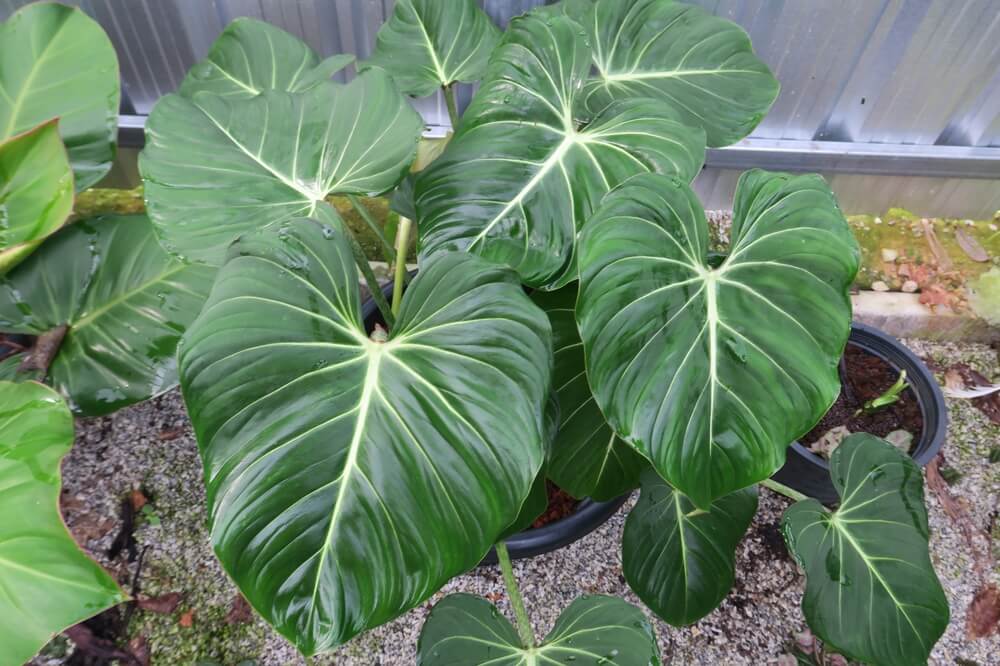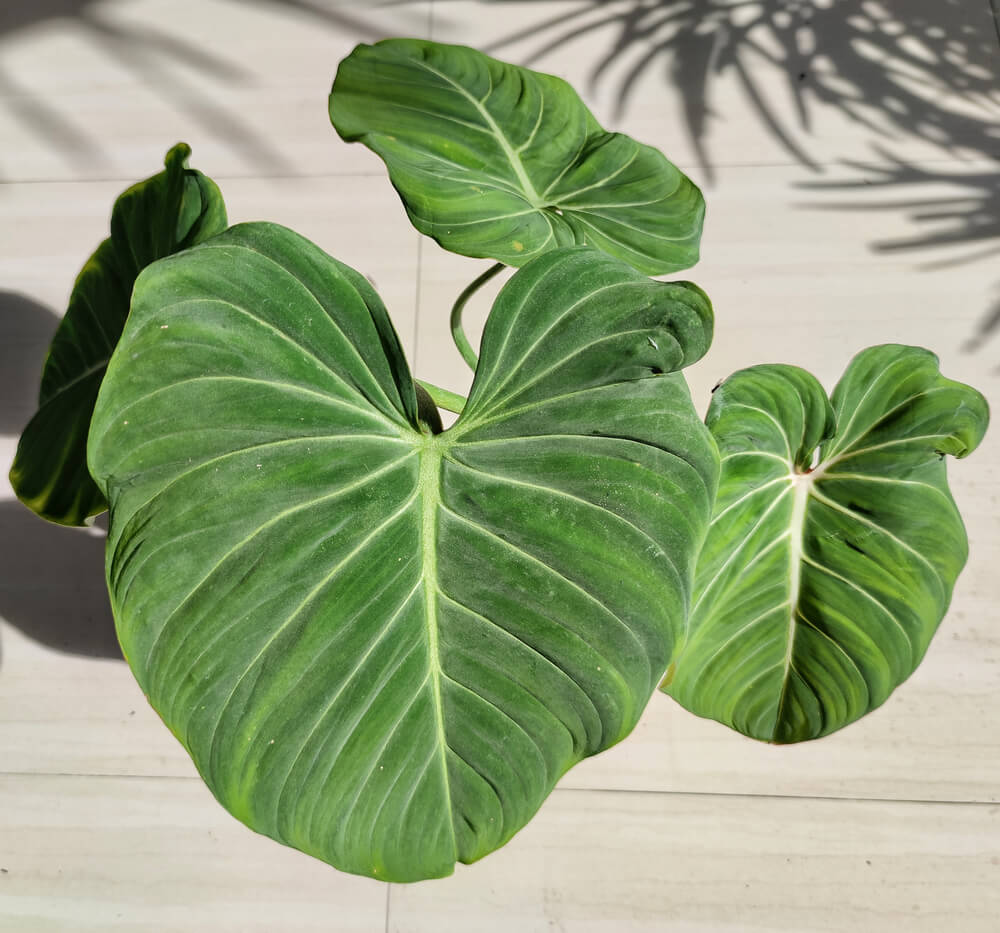If you love houseplants, you’ve probably heard the buzz about Philodendron Glorious and wondered what all the fuss was about. This rare Philodendron is prized for its large velvety leaves with distinctive light-colored edges and leaf veins.
It is a hybrid between Philodendron melanochrysum and Philodendron gloriosum. This dramatic climbing plant can reach heights of 6 to 9 feet at maturity and produces leaves up to 20 inches long and 8 inches wide. Find out what this unusual philodendron needs to thrive.
In This Article
What Growing Conditions Do Philodendron Glorious Need?
Like all philodendrons, Philodendron Glorious is part of the aroid (Araceae) family a family of plants native to tropical rainforests. These plants thrive in relatively low light; need loose, well-drained soil; thrive in average household temperatures with humidity levels between 60 and 80 percent; and require adequate water.
How Much Light Does a Philodendron Glorious Need?
Like other philodendrons, Philodendron Glorious prefers medium to bright indirect sunlight and will suffer in direct sun. Filtered light from an eastern or southern window is ideal.
You can use sheer curtains to soften the rays, but placing the plant several feet from the window is best. Direct sunlight will scald the leaves and inhibit their natural dark green coloring.
How Often Do You Water a Philodendron Glorious Plant?
Your Philodendron Glorious plant may need water once a week (or more) during the spring and summer when it is actively growing. During the fall and winter, when the plant is dormant and shows little new growth, it may need watering every 10 to 14 days.
How frequently it needs to be watered depends on the size and growth rate of the plant, environmental conditions like heat and humidity, the size of the plant pot, and the amount of soil.
Typically, your Philodendron Glorious should be watered when the top half of the soil feels dry to the touch.
Does Philodendron Glorious Need High Humidity?
As a tropical plant, the Philodendron Glorious prefers a relative humidity between 60 and 80 percent. Because the humidity level in your home in the winter typically ranges between 25 and 35 percent, you will need to increase the humidity level near your plant for it to thrive. Here’s how:
- Use a humidifier. This is the easiest and most reliable way to raise the humidity level for your plants, but it isn’t the only way.
- Group several houseplants close together. Water evaporating from the soil and moisture given off during the plant’s transpiration will help keep the air moist.
- Use pebble trays. Filling a shallow tray with pebbles and filling it with water to the top of the pebbles is a great way to add moisture to the air. Set your plants on top of the pebbles, using care that the roots do not touch the water.
Should I Mist Philodendron Glorious?
Philodendron Glorious prefers humid air and will suffer if the air is too dry, leading many to recommend misting the plant. However, misting isn’t likely to be very effective in raising the relative humidity, says the Iowa State University Extension.
Misting houseplants would need to be done several times a day to raise the humidity near your plants as the moisture evaporates quickly from plant foliage.
Using a humidifier near the plant or placing the plant on a pebble tray filled with water is a more effective way to raise the humidity near your plant. Grouping several plants together is also effective in keeping the air near the plants moist.
What Kind of Soil Does Philodendron Glorious Need?
Philodendron Glorious is an aroid and needs light, airy soil that drains well. A soil mixture for aroids is best, but you can make your own philodendron soil mix.
Combine equal parts peat moss, orchid bark, and all-purpose potting soil with about ¼ part of perlite and mix it well.
How Do You Prune the Philodendron Glorious Plant?
Philodendron Glorious does not typically require pruning other than removing dead or dying leaves. To control the height of your Philodendron Glorious, pinch out the new leaves on the top of the plant.
How Do I Propagate a Philodendron Glorious Plant?
Philodendrons can be propagated with stem cuttings. Cut a 4 to 6-inch stem, cutting just below a leaf node, and remove the leaves from the bottom three inches of the cutting. Place the cutting in water and set it on a sunny windowsill. New roots will form along the stem in two to three weeks.
When Should I Repot the Philodendron Glorious?
Philodendrons need repotting when they have outgrown the current pot. If you see roots protruding through the drainage holes or coiling at the soil’s surface, your plant is rootbound and needs repotting.
Plants that have outgrown the pot also dry out quickly after watering them as there is not enough soil to hold water.
If you are unsure whether your plant is rootbound, slide it out of the pot and check the root ball. If it fills the pot, your plant needs repotting.
Can You Repot a Philodendron Glorious in the Winter?
Spring and early summer are the ideal times to repot plants as they are actively growing and will adjust quickly to a new pot. It is best to avoid repotting them in the fall and winter when the plant is resting and growth has slowed.
What Kind of Fertilizer Do I Need for My Philodendron Glorious Plant?
Philodendron Glorious thrives with a balanced houseplant fertilizer. But the timing and application of fertilizer varies.
During the spring and summer, when the plant is actively growing, you can fertilize it once a month, but during the winter, when the plant’s growth slows, it is best to withhold fertilizer.
As a rule, fertilize your philodendron plant from spring until fall, when it is actively growing. Withhold fertilizer from late October until spring, when new growth resumes.
What Are Some Common Problems for the Philodendron Glorious Plant?
The most common issue with Philodendron Glorious is its tendency to develop root rot in wet or dense soil. It is vital to check the soil frequently to ensure it drains well and does not remain soggy.
Developing a good water routine based on your plant’s needs is wise.
Trying to adhere to a schedule of watering your plant once a week can lead to over or under-watering, depending on your plant’s needs. Remember that watering recommendation are guidelines, but your plant’s health should be your ultimate guide.
Frequently Asked Questions
The Philodendron Glorious is a hybrid between Philodendron Gloriosum and Philodendron Melanochrysum and embodies some characteristics of each. Its official name is Philodendron Gloriosum x Melanochrysum.
Philodendron Glorious is classified as a rare species of philodendron, but the term rare in relationship to houseplants may surprise you. According to A Natural Curiosity, a website devoted to the care of houseplants, the term rare may indicate one of several things.
- Difficult to find.
- Spectacular or unique.
- In high demand with low availability.
In the case of Philodendron Glorious, rare most likely refers to its uniqueness and may refer to the fact that it has recently gained popularity and is highly sought after.
A mature philodendron, glorious grown in ideal growing conditions, can reach a height of 6 to 9 feet when given proper support.
Glorious leaves grow to 20 inches long and 8 inches wide in ideal growing conditions.
Many grow philodendron Glorious inside as a houseplant as it adjusts well to average household conditions. However, it needs a humidity level between 60 and 85 percent to thrive.
A humidifier or pebble trays can be used, especially during the winter, to raise the humidity levels in the home. Likewise, you can grow your philodendron in the bathroom if room and light allow.
Philodendron Glorious can be grown outside in a shady location in the summertime but will not tolerate frost. Bring your plant inside in late summer or early fall when nighttime temperatures drop to 50 degrees.
Though both Philodendron Glorious and Splendid are beautiful plants, they have some key differences. Philodendron Glorious is more compact, with a shorter stem and smaller leaves. It also has a more upright growth habit, while Splendid tends to sprawl more. Finally, Philodendron Glorious’s leaves are more glossy and have a deeper green color.
Though both plants are philodendrons, they couldn’t be more different! Philodendron Glorious is an upright plant with glossy green leaves, while Melanochrysum is a trailing plant with dark burgundy leaves. Philodendron Glorious is also much more compact than Melanochrysum.
If you are wondering if Philodendron Gloriosum and Philodendron Glorious are the same plants, you are not alone. These two are often confused due to their similar name, but they are not the same.
Philodendron Glorious is a hybrid between Philodendron melanochrysum and Philodendron gloriosum. That means that Philodendron Glorious is the offspring of Philodendron Gloriosum.
Philodendron Glorious is neither a climber nor a crawler – it’s an upright plant.
Yes, Philodendron Glorious is a fast-growing plant!
One way to tell if a philodendron is glorious is by its growth habit – it should be upright and compact, with glossy green leaves.
No, Philodendron Glorious is not vining – it’s an upright plant.
An online search reveals Philodendron Glorious available on rare plant sites, eBay, and Etsy. You may also find Philodendron Glorious at reputable florists and plant centers but aren’t likely to find one in the plant section of grocery or retail outlets.
Expect to pay between 40 and 100 dollars for a Philodendron Glorious.
Additional Sources & Resources
1. https://www.researchgate.net/publication/321188973_A_Taxonomic_ Revision_of_the_Philodendron_Gloriosum_Species_Complex
2. https://eurekalert.org/pub_releases/2018-08/uob-rts080718.php
3. https://www.nature.com/articles/s41598-018-30897-0
4. https://link.springer.com/content/pdf/10.1186%2F1471-2229-14-257.pdf
5. http://biotaxa.org/Phytotaxa/article/view/phytotaxa.261.2.7
6. https://www.jstor.org/stable/25071497?seq=1
7. https://onlinelibrary.wiley.com/doi/full/10.1111/nph.14935
8. https://link.springer.com/content/pdf/10.1007%2Fs12225-018-9754-9.pdf
9. Philodendron species – Wikipedia, the free encyclopedia (n.d.). Retrieved March 15, 2021, from https://en.wikipedia.org/wiki /Philodendron_species
10. Kew World Checklist of Selected Plant Families (n.d.). Retrieved March 15, 2021, from https://wcsp.science.kew.org/namedetail.do?name_id=471897
11. Smith LI., & Clemants SE. (2006). Philodendron of the World. Timber Press, Inc..
12. Croat TB. (1978). A revision of Philodendron subgenus Meconostigma (Araceae). Annals of the Missouri Botanical Garden 65(3): 476-540.
13. Mayo SJ, Bogner J, Boyce PC, Bunting AHJ, Buttiker W, Croat TB, … & Taylor CW Jr (1991). An infrageneric classification of Philodendron (Araceae). Botanical Journal of the Linnean Society 106(4): 321-369.
14. Boyce PC. (2007). A revision of Philodendron section Philodendron (Araceae: Panicoideae: Anthurieae) for Costa Rica and Panama. Annals of the Missouri Botanical Garden 94(1): 153-206.
15. Mayo, S.J., Bogner, J., Boyce, P.C., Bunting, A.H., Buttiker, W., Croat, T.B., … & Taylor, C.W Jr (1991). An infrageneric classification of Philodendron (Araceae).


